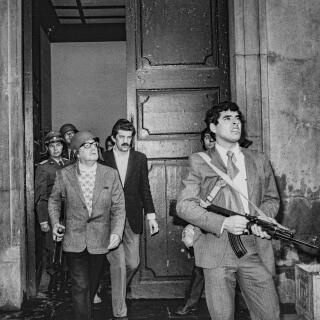That day, Salvador Allende would die by shooting himself in the head, but at 9:45 am on September 11, 1973, the president of Chile, 65, still looked like a fighter. The army had just launched a putsch. Holed up in his palace of La Moneda in Santiago, he went down to the courtyard with some of his closest allies. In the photograph, his helmet is askew and the strap dangles. The tweed jacket hangs by the bottom button, the sweater looks incongruous, and the step appears hesitant, but the right hand firmly grips an AK47 automatic rifle held to the shoulder – a gift from Cuba's Fidel Castro. His gaze is fixed on the sky. He could see Hawker Hunter fighter planes flying low overhead. This was where the military's bombing raids would come from later.
All this can be seen and felt in a photograph that has become iconic, widely distributed, and published over the last five decades in newspapers, books, exhibitions, conferences, documentary films... In 2016, the American magazine Time selected it as one of its "100 Most Influential Photos" ever captured. Historians have analyzed and compared it with five others, taken a little before and after his death. The material is a mine of information on Allende's last hours. There are six images, then, but this one crushes others to the point of being commonly called Allende's "last photo."
It shows what you never see: The critical moment when history is turned upside down and when a democratically elected man falters in the face of a coup in a continent experiencing so many. The cliché has become a symbol of resistance. But also one of the powerlessness of a leader caught between a radical left preferring "guns to votes" and a right ready to stir up economic disorder with the support of the United States President Richard Nixon, who called his Chilean counterpart a "son of a bitch."
Then there was Allende, the person. The entire European left was fascinated by this bourgeois who had come to power through the ballot box and exercised it through reform, in contrast to the Cuban-style revolution. These European leftwingers closely watched the three years of Allende's Popular Unity government, particularly in France, where the Socialists and Communists were trying to define themselves. The vision of this trained surgeon with a machine gun came as a shock...
"A Mitterrand with a gun in his fist," said Robert Pledge, director of the Contact photo agency, who interviewed Allende in 1971. Pledge, now 81, summed up the global emotion during the 1973 coup. Asked how he learned of the development, he said: "I was in a phone booth on New York's 5th Avenue. It was the first time in my life that I cried for political reasons."
You have 74.6% of this article left to read. The rest is for subscribers only.
